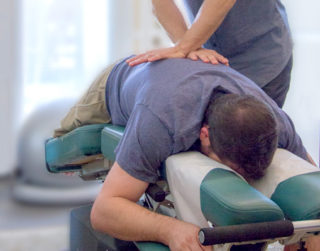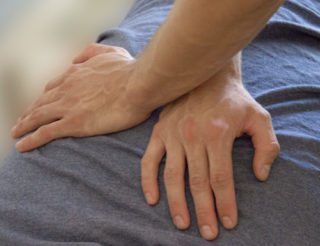
WHAT IS CHIROPRACTIC?
Chiropractic is the second largest primary healthcare profession. It takes a drug free, hands on approach to healing with extensive training in several methods of manual treatment, corrective rehabilitation exercises, stress management, injury prevention and nutritional guidance.
Doctor’s of Chiropractic (DC) are trained to diagnose and treat the body as a whole, including any pain of the musculoskeletal system (neck, back, arms, legs, wrist, knees, jaw, abdomen etc.), nervous system, organ systems, lymphatic systems, and any other conditions that may interfere with the body’s overall health.
It is this comprehensive approach to all aspects of the patient’s health that enables chiropractors to look at the big picture, and correct the cause of your symptoms rather than simply masking them.
TECHNIQUES & THERAPIES
There are over 300 adjusting techniques chiropractors use, ranging from a quick thrust to a gentle touch. Most doctors choose one technique that they prefer and only offer that option to their patients. At Longevity Chiropractic, we practice a wide variety of techniques enabling us to tailor a treatment plan specific to your unique condition, body type and personal preference so that you can finally get the care you deserve.
- QSM3
- Pregnancy
- Pediatric
- Spinal Decompression
- Flexion Distraction
- Drop Table
- Activator
- Myofascial Release
- Dry Needling
 Quantum Spinal Mechanics (QSM3) is the most innovative and forward thinking technique in chiropractic today that focuses on correcting the patient’s posture from head to toe, putting their body in the optimal position for healing and overall function.
Quantum Spinal Mechanics (QSM3) is the most innovative and forward thinking technique in chiropractic today that focuses on correcting the patient’s posture from head to toe, putting their body in the optimal position for healing and overall function.
The adjustment itself has NO FORCEFUL TWISTING, POPPING, OR CRACKING of the spine in any way, making it suitable for everyone from infants to the elderly, and even those who’ve had spine surgery in the past. During the adjustment a gentle touch is applied to the upper neck and head area in specific manner to release the pathways of tension that hold the body in its twisted, compressed, and misaligned state.
This gentle, yet highly effective postural correction technique has provided relief for many people suffering with chronic neck and back pain, as well as a host of other serious conditions.
Symptoms:
• Vertigo
• Fibromyalgia
• Migraine/Headaches
• TMJD (Temperomandibular Joint Disorder)
• Sciatica
• Hypertension
• Scoliosis
• Frozen Shoulder
• TN (Trigeminal Neuralgia)
• Bells palsy and much more
 Webster Technique can be done on anyone, but is specially designed for use throughout the entirety of pregnancy. When performed, the doctor uses a specific set of gentle, NON-force adjustments that focus on releasing tension, aligning the pelvis without any twisting seen in traditional adjustments of the pelvis and lower back. During pregnancy, your body is overall much looser than normal from an increase in the hormone relaxin, which is why side posture adjustments where they twist you like a pretzel may tweak mom’s respiratory and/or pelvic diaphragm muscles, which she’s going to want full function of on the big day.
Webster Technique can be done on anyone, but is specially designed for use throughout the entirety of pregnancy. When performed, the doctor uses a specific set of gentle, NON-force adjustments that focus on releasing tension, aligning the pelvis without any twisting seen in traditional adjustments of the pelvis and lower back. During pregnancy, your body is overall much looser than normal from an increase in the hormone relaxin, which is why side posture adjustments where they twist you like a pretzel may tweak mom’s respiratory and/or pelvic diaphragm muscles, which she’s going to want full function of on the big day.
Expecting Moms should be adjusted at least once a week throughout their pregnancy, or more at the beginning if you’ve never been adjusted before OR when experiencing pain or discomfort.
Webster Technique has been shown to:
• Help decrease pain or abnormal progress of labor (known as dystocia)
• Create more space in pelvis and abdomen of mom so baby can grow unrestricted
• With more room, it’s also easier for the baby to move down into proper position when the time comes
• Decrease in incidence of birth trauma and unnecessary medical interventions
 Pediatric There are several gentle, non-force techniques including SOT, Cranial and other intra-oral work used when adjusting an infant or toddler to make sure they can thrive without interference during these crucial stages of early development, which ultimately sets up the framework for their neurology that they will continue to build on the rest of their life.
Pediatric There are several gentle, non-force techniques including SOT, Cranial and other intra-oral work used when adjusting an infant or toddler to make sure they can thrive without interference during these crucial stages of early development, which ultimately sets up the framework for their neurology that they will continue to build on the rest of their life.
Even if your infant had a “normal” birth with no obvious issues, these fragile little humans still undergo a large amount of stress during labor with that long journey through the birth canal, and they need to get their body checked and examined for misalignments before their body decides to just work around the issue.
Every infant should go to a Chiropractor that specializes in pediatrics as soon as the parents are comfortable taking them out of the house so they can be evaluated for proper reflexes for their age, check whether or not they have tongue or lip ties that may affect breastfeeding or speech down the road, as well as their overall structure and function to make sure they’re firing on all cylinders.
Getting your child adjusted EARLY ON and REGULARLY throughout development has been shown to help with the following: Colic, Constipation, latching issues with breastfeeding, tongue-ties or lip ties, torticollis and other postural/structural issues, faulty movement patterns, ear infections, behavioral issues, sensory issues and special needs.
 Spinal Decompression Therapy is done with the patient laying down on the specially designed table shown here, that mechanically stretches your spine to the weight set by the doctor based on how sensitive your back is and how well you did the previous visit. You sit back and relax while the device gently and slowly stretches your spine and decompresses the disc space between each vertebrae thus taking the pressure off the nerve and surrounding muscle tissue.
Spinal Decompression Therapy is done with the patient laying down on the specially designed table shown here, that mechanically stretches your spine to the weight set by the doctor based on how sensitive your back is and how well you did the previous visit. You sit back and relax while the device gently and slowly stretches your spine and decompresses the disc space between each vertebrae thus taking the pressure off the nerve and surrounding muscle tissue.
This is typically done for 15-30 minutes at a time, initially a few times per week paired with chiropractic adjustments and/or massage therapy until the desired results are achieved. After this, it is recommended to still come in at least once per month to keep your spine decompressed and functional.
This therapy has provided relief for even the most serious cases of sciatica, degenerative disc disease, cervical radiculopathy and other issues with pinched nerves and compression. You must be an existing patient to use our decompression table because we need to first do an exam of your spine to make sure it’s the right therapy for you!
 Flexion Distraction Table A slow moving table that gently tractions the spine, inducing motion while the doctor is able to use both hands to target your specific areas of concern. This is a safe and scientifically proven alternative to back surgery for disc herniations, sciatica, stenosis, spondylolisthesis and a number of other spinal conditions.
Flexion Distraction Table A slow moving table that gently tractions the spine, inducing motion while the doctor is able to use both hands to target your specific areas of concern. This is a safe and scientifically proven alternative to back surgery for disc herniations, sciatica, stenosis, spondylolisthesis and a number of other spinal conditions.
Symptoms:
• Sciatica
• Disc bulges and herniations
• Arthritis / Spinal Degeneration
• Spinal Stenosis
 Drop Table Sections are built into the table that drop about an inch when the doctor delivers a gentle thrust, allowing gravity to assist in the adjustment. This allows the doctor to apply less force, while the patient is able to lie flat instead of getting twisted around, which provides for a comfortable adjustment.
Drop Table Sections are built into the table that drop about an inch when the doctor delivers a gentle thrust, allowing gravity to assist in the adjustment. This allows the doctor to apply less force, while the patient is able to lie flat instead of getting twisted around, which provides for a comfortable adjustment.
Symptoms:
• Musculoskeletal Pain
• Sciatica
• Hip Pain
• Disc Bulges
• Herniations
 Activator Using a small, handheld, spring-loaded device that delivers a gentle and precise impulse, mimicking the thrust of a chiropractic adjustment. There are several clinical trials to support its efficacy, and this is yet another great tool for adjusting children and the elderly.
Activator Using a small, handheld, spring-loaded device that delivers a gentle and precise impulse, mimicking the thrust of a chiropractic adjustment. There are several clinical trials to support its efficacy, and this is yet another great tool for adjusting children and the elderly.
Symptoms:
• Musculoskeletal Pain
• TMJD
• Arthritis
• Spinal Degeneration
 Myofascial Release A technique where the doctor uses his hand, elbow, knee, or forearm to apply pressure to a muscle or muscle group as it is brought through its full range of motion, breaking up adhesions and scar tissue which improves motion and blood flow. This should be done after all sports injuries to speed up the healing process and restore normal function so you can get back in the game.
Myofascial Release A technique where the doctor uses his hand, elbow, knee, or forearm to apply pressure to a muscle or muscle group as it is brought through its full range of motion, breaking up adhesions and scar tissue which improves motion and blood flow. This should be done after all sports injuries to speed up the healing process and restore normal function so you can get back in the game.
Symptoms:
• Sports Injuries (Acute & Chronic)
• Musculoskeletal Pain
• Anxiety
• Stress

Dry Needling is similar to acupuncture in the sense the doctor is using the same type of needle, but rather than targeting meridians like an acupuncturist would, Dr. Long will be targeting the tender bands of contracted muscle known as trigger points. By placing a needle through the fascia and into the muscle belly, you are able to bring an increase in blood supply to that area to help promote healing for both acute and chronic issues. At the same time this causes your body to naturally release endogenous opioids to assist in pain relief and get the contracted muscle to relax back to it’s original length where it will function optimally.
Fun fact: These dry needles we use are a very thin filament that measure 20 times smaller than a wet needle, which is what you would use to inject some type of liquid through such as a cortisone injection. Patients are often surprised by how little you feel the needle enter your skin, if at all.










